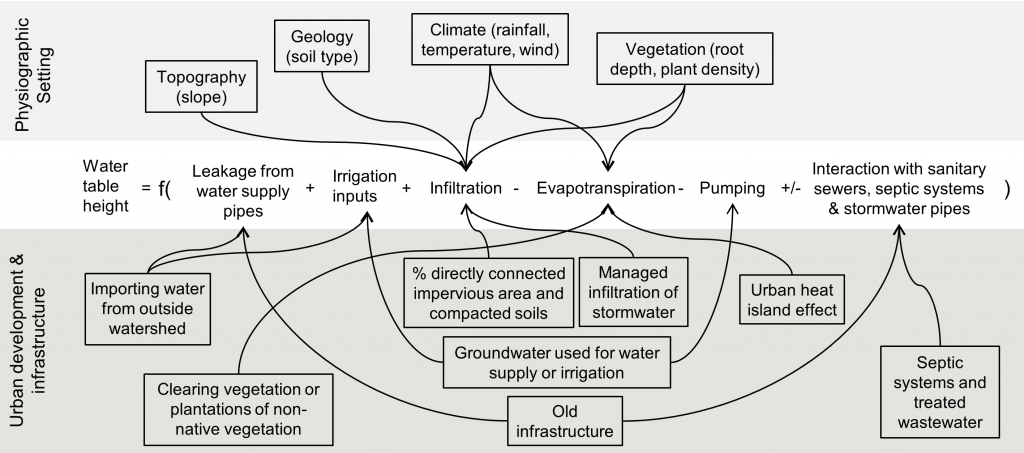The following a general public summary of the Freshwater Science article.
Bhaskar, A.S., L. Beesley, M.J. Burns, T.D. Fletcher, P. Hamel, C.E. Oldham, and A.H. Roy (2016), Will it rise or will it fall? Managing the diverse effects of urbanization on base flow, Freshwater Science, 35(1), 293-310, doi: 10.1086/685084.
Groundwater and stream base flow
The flow of groundwater is why many streams do not dry up days or weeks after the last rain storm. During dry weather, groundwater commonly flows slowly towards streams (at a rate that is related to the height of the water table) and provides a consistent source of water to streams. This flow of groundwater feeding streams, called base flow, is critical to sustaining life that lives in and around streams.
Changing amounts of stream base flow (both falls and rises) can be detrimental to stream ecology and human populations. Ecological risks of falling stream base flow include more extreme water temperatures, reduced water height, and greater chance of streams drying up, whereas human risks are related to reduced water supplies for drinking and irrigation. Rising base flow disturb stream ecology causing flooding or waterlogging of vegetation along stream banks, changes in the composition of species that live in the stream, and a decline in stream water quality if the groundwater is carrying excess nutrients. Risks to humans of rising water tables or base flow include flooding of houses, basements, and underground infrastructure near streams.
Diverse mechanisms affecting water tables and base flow
A stream’s base flow depends on the topography, geology, climate, and vegetation of the area draining to the stream. Urban development introduces other factors can also affect stream base flow. The most obvious is the creation of roads, rooftops, and parking lots, because these impervious surfaces prevent rain from infiltrating into the ground. By itself, impervious surfaces typically cause water tables and stream base flow to fall; however, in some instances stream base flow actually rises. If we look in more detail, we see that there are a variety of ways that urbanization can affect water table height and stream base flow (Figure 2). For example, leaking water supply pipes, the clearing of vegetation that takes up water, and management actions designed to increase stormwater infiltration will contribute towards a rise in water tables and base flow. In contrast, cracked wastewater pipes that drain groundwater, the shunting of stormwater runoff to streams via stormwater drains, or the direct pumping of groundwater will contribute towards a rise in water tables and base flow.

Figure 2. Water-table height as a function of multiple factors that affect the water balance of an area. Reproduced from Bhaskar, A.S., L. Beesley, M.J. Burns, T.D. Fletcher, P. Hamel, C.E. Oldham, and A.H. Roy (2016), Will it rise or will it fall? Managing the diverse effects of urbanization on base flow, Freshwater Science, doi: 10.1086/685084.
Decision-support framework to predict the base flow change with urbanization
Perhaps because of this complexity, few simple tools exist to help water managers predict baseflow change in their local urban area. We address this management need by presenting a decision-support tool that can be used to predict the likelihood and direction of baseflow change based on the natural vulnerability of the landscape and aspects of urban development. The tool is embedded in an adaptive-management framework that encourages managers to define their ecological objectives, assess the vulnerability of their ecological objectives to changes in water-table height, and monitor baseflow responses to urbanization.
We tested our framework with two case studies: Perth, Western Australia, and Baltimore, Maryland, USA. In Perth, a Mediterranean climate, highly permeable soils, flat topography, possible loss of vegetation under urbanization, and management of stormwater by wide-spread infiltration interacted such that urbanization led to rising base flow. In Baltimore, the unintended infiltration of groundwater into leaky wastewater infrastructure and the classic evacuation stormwater management of draining impervious surfaces directly to streams led to a predicted fall in stream base flow. Together, these studies show how water-table height before development, climate, and geology together with aspects of urban infrastructure affect the changes in base flow observed with urban development. Greater consideration of subsurface components of the water cycle will help to protect and restore the ecology of urban freshwaters.
